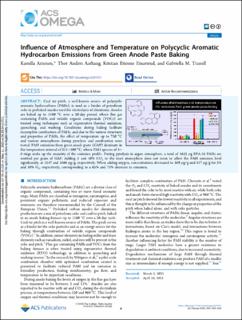| dc.contributor.author | Arnesen, Kamilla | |
| dc.contributor.author | Aarhaug, Thor Anders | |
| dc.contributor.author | Einarsrud, Kristian Etienne | |
| dc.contributor.author | Tranell, Maria Gabriella | |
| dc.date.accessioned | 2023-06-13T11:48:08Z | |
| dc.date.available | 2023-06-13T11:48:08Z | |
| dc.date.created | 2023-05-11T09:04:46Z | |
| dc.date.issued | 2023 | |
| dc.identifier.citation | ACS Omega. 2023, 8 (20), 18116-18121. | en_US |
| dc.identifier.issn | 2470-1343 | |
| dc.identifier.uri | https://hdl.handle.net/11250/3071140 | |
| dc.description.abstract | Coal tar pitch, a well-known source of polycyclic aromatic hydrocarbons (PAHs), is used as a binder of petroleum coke in prebaked anodes used for electrolysis of aluminum. Anodes are baked up to 1100 °C over a 20-day period, where flue gas containing PAHs and volatile organic compounds (VOCs) are treated using techniques such as regenerative thermal oxidation, quenching, and washing. Conditions during baking facilitate incomplete combustion of PAHs, and due to the various structures and properties of PAHs, the effect of temperature up to 750 °C and various atmospheres during pyrolysis and combustion were tested. PAH emissions from green anode paste (GAP) dominate in the temperature interval of 251–500 °C, where PAH species of 4–6 rings make up the majority of the emission profile. During pyrolysis in argon atmosphere, a total of 1645 μg EPA-16 PAHs are emitted per gram of GAP. Adding 5 and 10% CO2 to the inert atmosphere does not seem to affect the PAH emission level significantly, at 1547 and 1666 μg/g, respectively. When adding oxygen, concentrations decreased to 569 μg/g and 417 μg/g for 5% and 10% O2, respectively, corresponding to a 65% and 75% decrease in emission. | en_US |
| dc.language.iso | eng | en_US |
| dc.publisher | ACS | en_US |
| dc.rights | Navngivelse 4.0 Internasjonal | * |
| dc.rights.uri | http://creativecommons.org/licenses/by/4.0/deed.no | * |
| dc.title | Influence of Atmosphere and Temperature on Polycyclic Aromatic Hydrocarbon Emissions from Green Anode Paste Baking | en_US |
| dc.title.alternative | Influence of Atmosphere and Temperature on Polycyclic Aromatic Hydrocarbon Emissions from Green Anode Paste Baking | en_US |
| dc.type | Peer reviewed | en_US |
| dc.type | Journal article | en_US |
| dc.description.version | publishedVersion | en_US |
| dc.rights.holder | © 2023 The Authors. Published by American Chemical Society. | en_US |
| dc.source.pagenumber | 18116-18121 | en_US |
| dc.source.volume | 8 | en_US |
| dc.source.journal | ACS Omega | en_US |
| dc.source.issue | 20 | en_US |
| dc.identifier.doi | 10.1021/acsomega.3c01411 | |
| dc.identifier.cristin | 2146853 | |
| dc.relation.project | Norges forskningsråd: 237738 | en_US |
| cristin.ispublished | true | |
| cristin.fulltext | original | |
| cristin.qualitycode | 1 | |

